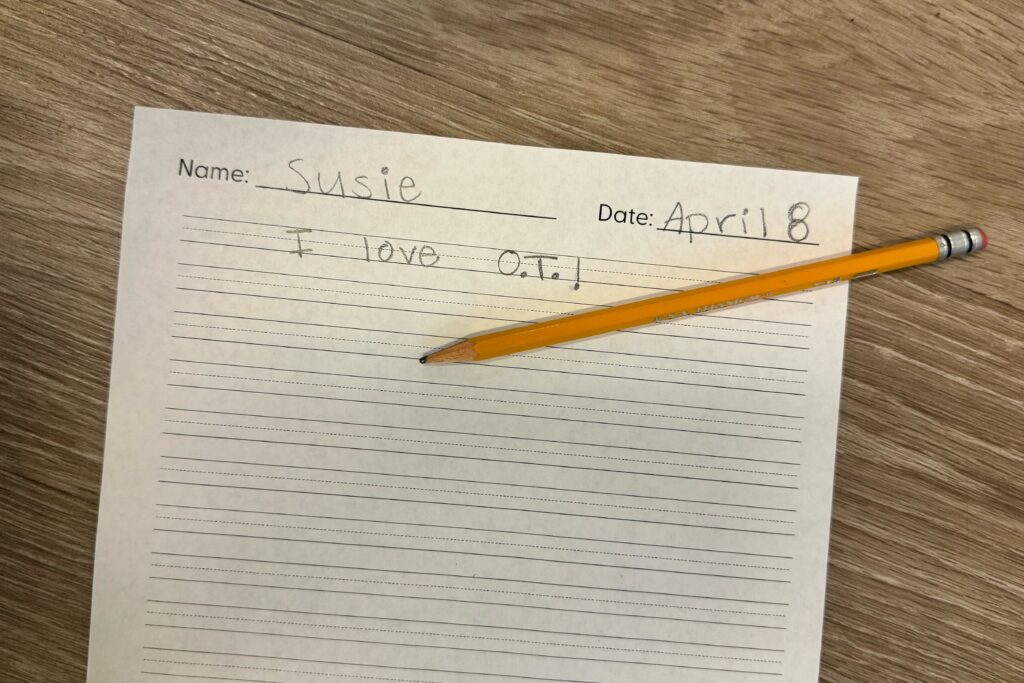
Handwriting is an incredibly complex skill. Many times, the difficulties might get overlooked. Here is a list of what an occupational therapist might observe or assess during a routine handwriting assessment:
- Posture at Tabletop: A therapist might help you ensure that the child is sitting 90-90-90 positioning with feet flat on the floor or a flat surface (i.e. a stool, a box, large books, etc.) and the hips appropriately positioned. This is optimal positioning and can help assist with compensating for some core strength deficits as core strength can directly impact handwriting (see below).
- Core Strength: A child must have a strong core to be able to appropriately utilize their wrist and hand movements dynamically. Therapists will often utilize the term “proximal stability equals distal mobility” meaning that when the center of the body is unstable, it is much harder to control movements with your wrist and fingers (the body parts that are further from the midline).
- Crossing Midline: The ability to cross the midline of the body (an invisible line splitting the body into right and left sides) is an important skill to work on when introducing handwriting as writing typically occurs in the center on the body causing a person’s dominant hand to begin on one side of the body and fluidly cross to the other without disruptions.
- Bilateral Coordination: Handwriting involves the skill of utilizing both sides of the body with asymmetrical movement patterns. The most notable bilateral coordination aspect includes being able to hold the paper with one hand while consistently writing with the other hand.
- Prewriting Strokes/Shapes: A child might not be ready to initiate handwriting yet if they are unable to trace and copy circles, squares, crosses, lines, or a combination of any of those. A therapist would observe copying an already drawn out shape and then might ask the child to imitate the line or shape after an initial visual model is provided. Sometimes, a therapist might also cue with “circle, stop” in order to help a child understand to pick their writing utensil up off the paper at the end of the shape.
- Attention: A therapist might look at how long a child can remain seated and attend to preferred tasks for the length of time that is expected for a handwriting assignment or handwriting practice. With fleeting attention, writing skills can be more difficult such as visual scanning as well as remaining seated or in any one position.
- Sensory Processing Skills: Sensory processing encompasses the body as a whole and how a child or adult processes the information provided by our environment. If there are difficulties in one or more areas, a child may struggle with the demands of handwriting. For example, if the child is struggling at school, but not when practicing at home, a contributing factor could be an auditory or visual distractor preventing the child from being able to focus on the demands of writing.
- Fine Motor Endurance: This represents the ability to sustain multiple repetitions of the fine motor skills needed for handwriting for prolonged periods of time at the same intensity as the beginning. For example, being able to actively move the hand, wrist, and fingers in the appropriate directions for writing versus compensating with the entire arm or initiating the move from the elbow instead. Children who have poor fine motor endurance may not enjoy coloring and would rather draw instead. They might avoid certain tasks that require a sustained or stationary grasp or that they perceive has a large area to color.
- Visual Motor Skills: Specifically with handwriting, an OT would look at visual scanning along with tracking, convergence, divergence, and any other visual abnormalities that are not always tested in routine vision exams. To far point copy (or copy from a board at school), the child must be able to smoothly scan up and down and maybe even some side to down depending on the positioning of the child’s desk or other writing space without losing their place on the line as well as being able to recall from a visual memory standpoint a variety of letters and numbers. Visual motor skills also come into play with spacing, sizing, and remaining on the provided lines or inside the boxes.
- Grasping: A therapist can assess if a child currently has a “functional grasp pattern”. This can start as young as 3 years old to see if a child can hold a variety of large and small items in an ergonomical and safe position for their joints and muscles.
Depending on your child’s specific needs including motivation level, age, current handwriting level, and ability to complete certain functional tasks, a therapist may observe more than the above and take more skills into account. However, the above items are some of the more commonly assessed areas throughout an initial evaluation and ongoing treatment sessions.
Written by:
Chandon Hines, M.S.OTR/L
Child’sPlay Therapy Center- Huntsville

